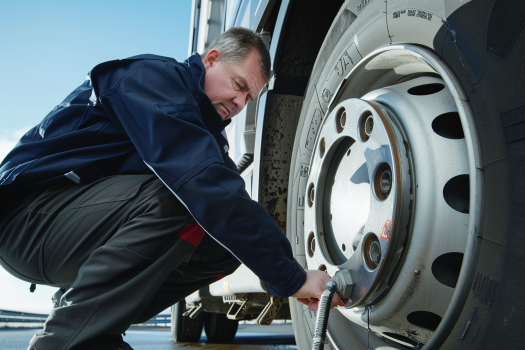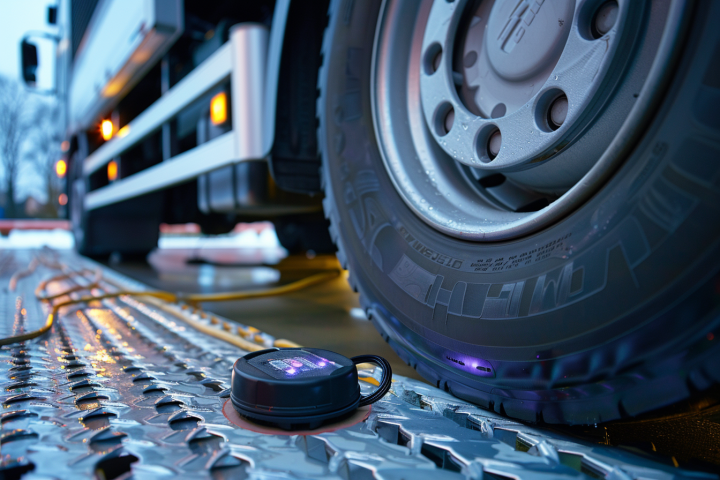Last Updated on August 28, 2024
Introduction To TPMS Sensors
TPMS, or Tire Pressure Monitoring System, is a critical component of modern trucking that ensures the safety and efficiency of commercial vehicles. These systems are designed to monitor and provide real-time information about tire pressure, alerting drivers and fleet managers to potential issues. Understanding TPMS sensors and their significance in trucks is paramount for safe and cost-effective transportation.
Understanding TPMS Sensors
TPMS (Tire Pressure Monitoring System) sensors maintain proper tire pressure. They give real-time pressure data, warning drivers of underinflated tires, which can improve safety, fuel efficiency, and tire lifespan.
- Sensor Functionality: TPMS sensors are small devices in each tire, usually inside the valve stem or mounted to the rim. Tire pressure and temperature are continuously measured in some modern systems.
- Real-Time Data: These sensors send real-time data to the truck’s onboard computer system. This information is critical for tracking tire health during a voyage.
- Alert Mechanisms: When a TPMS sensor detects low tire pressure or an irregularity, it alerts the truck’s dashboard. Drivers receive immediate alerts, allowing them to take appropriate action.
- Sensor Types: TPMS sensors come in two main types—direct and indirect. Direct sensors measure pressure directly from within the tire, while indirect sensors infer pressure based on wheel speed and other vehicle parameters.
- Battery Life: Because TPMS sensors’ batteries have a limited lifespan of 5 to 10 years, they must be replaced as needed to ensure accurate monitoring.

The Significance of Tire Pressure in Trucks
Truck tire pressure is critical for safety, load capacity, and fuel economy. Properly inflated tires lower the danger of tire failure, improve traction and handling, and promote even tire wear, extending tire life.
- Safety: For trucks, having the correct tire pressure is essential. Underinflated tires increase the risk of blowouts, skidding, and collisions. Because they issue early warnings, TPMS sensors are critical in averting such catastrophes.
- Fuel economy: Fuel economy is increased when tires are kept at the proper pressure. Underinflated tires increase rolling resistance, which increases engine effort and fuel consumption.
- Tire Lifespan: Insufficient tire pressure shortens the tire’s lifespan by accelerating deterioration. Tire preservation is aided by TPMS sensors, guaranteeing that tires are consistently appropriately filled.
- Load Capacity: Trucks are frequently used to transport large goods. Accurate tire pressure is crucial to guarantee that the tires can safely handle the weight of the cargo.
- Compliance: In many nations, the law requires using TPMS in commercial vehicles. Adhering to these standards is imperative to prevent fines and penalties.
Regular monitoring and maintenance of TPMS sensors can prevent accidents, reduce operational costs, and extend the lifespan of truck tires.
Why TPMS Sensors Matter
TPMS sensors are a crucial safety feature that can significantly prevent accidents and blowouts on the road. This section will explore why TPMS sensors matter and how they provide real-time monitoring to enhance safety.
Real-Time Monitoring for Enhanced Safety
Truck monitoring systems that provide real-time performance data, such as TPMS, significantly increase safety. This allows for quick reaction to possible problems, such as tire pressure fluctuations, which improves handling and lowers the chance of accidents.
- Continuous Watchfulness: TPMS sensors act as a truck tire’s guardian angel. By offering constant tire pressure monitoring, they ensure drivers are always informed of the state of their tires.
- Instant Alerts: The TPMS sensors immediately notify the driver when they see a decrease in tire pressure. Thanks to this timely information, the motorist can act in anticipation of a potentially dangerous scenario.
- Decreased Risk of Blowouts: Underinflated Tires run a greater risk of blowing out due to overheating. By assisting in maintaining ideal tire pressure, TPMS sensors lessen the possibility of blowouts, which can cause mishaps, injuries, and even fatalities.
- Better Handling: Tires with the correct air pressure offer increased stability and handling, particularly in emergencies or abrupt lane changes. TPMS sensors guarantee tires are in the best possible shape for these maneuvers.
- Weather Adaptability: Temperature variations can affect tire pressure. Tire pressure is kept safe in all weather situations thanks to TPMS sensors, which consider these variances.
Preventing Accidents and Blowouts
Frequent tire condition checks and pressure monitoring are crucial to preventing blowouts and truck accidents. Correctly inflated tires with proper maintenance lessen blowout risks and drastically lower the chance of tire failure-related incidents.
- Preventing Accidents: The National Highway Traffic Safety Administration (NHTSA) states that tire problems significantly contribute to traffic accidents. TPMS sensors are critical in lowering these accidents by keeping tire pressure within safe ranges.
- Extended Tire Lifespan: Blowouts pose a safety risk and result in premature tire replacement. TPMS sensors help extend tire lifespans by preventing overuse and unnecessary wear and tear.
- Preventing Accidents: The National Highway Traffic Safety Administration (NHTSA) states that tire problems significantly contribute to traffic accidents. TPMS sensors are critical in lowering these accidents by keeping tire pressure within safe ranges.
- Driver Confidence: Drivers who know that their trucks are equipped with TPMS sensors have greater confidence in their vehicles’ safety and reliability. This can lead to improved job satisfaction and retention rates for trucking companies.
The Economic Benefits
When it comes to managing a trucking fleet, the bottom line matters. TPMS sensors offer a range of economic benefits that can significantly impact a company’s profitability. In this section, we will explore these benefits in detail.
Extending Tire Lifespan
Maintaining the correct tire pressure, rotating and balancing your truck tires regularly, and doing frequent alignment checks can all help extend their lifespan. By following these guidelines, tires will wear evenly and are less likely to need to be replaced too soon.
- Preventing Underinflation: Underinflation is one of the main reasons tires wear out too soon. Underinflated tires produce too much heat and wear unevenly. To maintain the tires’ integrity, TPMS sensors ensure that tire pressure is consistently within the advised range.
- Even Wear Patterns: Properly inflated tires have an even wear pattern, extending their lifespan before requiring replacement. For trucking businesses, this longer lifespan means significant cost savings.
- Reduced Replacement Costs: Buying and mounting new tires for a fleet of trucks can be a significant expense. By extending the lifespan of existing tires, TPMS sensors reduce the frequency of tire replacement, saving both time and money.
- Optimal Performance: Tires in good condition provide better traction and handling. This not only enhances safety but also contributes to the efficient operation of the truck, reducing maintenance costs.
Reducing Fuel Consumption and Costs
Driving more fuel efficiently, minimizing excess weight, and maintaining proper tire pressure can lower fuel consumption and vehicle expenses. Over time, these actions will result in significant cost savings by improving fuel efficiency.
- Improved Fuel Efficiency: Underinflated tires create more rolling resistance, forcing the engine to work harder and consume more fuel. TPMS sensors help maintain proper tire pressure, improving fuel efficiency and reducing fuel costs.
- Environmental Impact: Lower fuel use helps a business’s bottom line and is suitable for the environment. Reduced fuel use leads to fewer greenhouse gas emissions, which allows the business project to create a more environmentally friendly image.
- Regulatory Compliance: Some regions have introduced regulations to limit fuel consumption and emissions. Compliance with these standards frequently involves financial rewards and penalties. TPMS sensors can help fulfill these demands.
- Maintenance Savings: Properly inflated tires minimize wear and tear on other components, such as suspension and brakes. This results in reduced maintenance costs and less downtime for repairs.
- Competitive Advantage: Companies that invest in TPMS technology enjoy cost savings and gain a competitive edge. They can offer more competitive pricing to their customers, attract new business, and maintain a strong reputation for efficiency.
Compliance and Regulations
Adhering to regulations is not just a matter of legality but an essential aspect of ensuring safety, efficiency, and reliability in commercial trucking. This section delves into the importance of compliance with TPMS regulations and how they can help trucking companies avoid penalties and fines.
TPMS Mandates for Commercial Vehicles
Commercial vehicles must have TPMS (tire pressure monitoring system) systems installed to comply with TPMS regulations. These regulations improve efficiency and safety by monitoring tire pressure. Adherence to these regulations is crucial for lawful operations and the enhancement of vehicle efficiency.
- Government Mandates: Numerous governments and regulatory agencies worldwide have acknowledged the significance of TPMS in commercial vehicles. Consequently, regulations requiring the installation and operation of TPMS sensors in trucks and other commercial vehicles have been introduced.
- Safety Considerations: Safety is the main reason behind TPMS regulations. Underinflated tires increase the risk of blowouts, skidding, and collisions. Trucks equipped with TPMS sensors are guaranteed to have a vital safety element that helps avert these kinds of accidents.
- Uniformity: TPMS regulations establish a uniform benchmark for the sector, guaranteeing that all commercial vehicles, irrespective of dimensions or function, are outfitted with this indispensable technology.
- Tire Pressure Monitoring and Reporting: Tire pressure monitoring and reporting requirements are commonly outlined in TPMS mandates. This guarantees fleet management and drivers are immediately informed of tire pressure issues.
Avoiding Penalties and Fines
Avoiding penalties and fines means listening to transportation regulations, including TPMS mandates and maintenance standards. Regular checks and documentation can ensure compliance, thus avoiding legal repercussions and ensuring uninterrupted operations.
- Legal Compliance: If TPMS requirements are not followed, fines and penalties may be in place. These penalties may differ based on the infraction’s jurisdiction and seriousness but may be substantial.
- Regulatory Oversight: To make sure that safety laws, such as TPMS rules, are being followed, regulatory bodies frequently inspect commercial cars. Operating licenses may be suspended, and fines may be assessed for noncompliance.
- Liability Concerns: If a commercial vehicle is involved in an accident and it is determined that the car did not adhere to TPMS requirements, the trucking business may be held entirely responsible for any resulting damages or injuries.
- Effect on Insurance: Failure to adhere to safety rules, such as TPMS requirements, may affect insurance coverage. If trucking companies don’t follow these rules, their insurance may be refused, or their rates increase.
- Reputational Damage: In addition to financial fines, noncompliance can harm a transportation company’s reputation. Consumers may become less trusting of a business that disregards safety and legal compliance.
How TPMS Works
Understanding how TPMS (Tire Pressure Monitoring System) works is essential to appreciating its role in ensuring truck safety and efficiency. This section will delve into the mechanics of TPMS and its sensor technology.
Sensor Technology Demystified
Sensor technology in trucks, particularly TPMS, involves sensors that monitor and transmit real-time tire pressure data. This technology helps detect under-inflation, over-inflation, or other tire-related issues, enhancing safety and maintenance efficiency.
- Pressure Sensing: TPMS sensors are equipped with pressure sensors that measure the air pressure inside each tire. These sensors detect even minor deviations from the recommended tire pressure.
- Wireless Communication: TPMS sensors are wireless devices that transmit data to the truck’s onboard computer system using radio frequency signals. This communication is essential for real-time monitoring.
- Battery Power: TPMS sensors are powered by batteries, which are designed to last for several years. The batteries ensure the sensors operate continuously, providing constant tire pressure updates.
- Sensor Location: TPMS sensors are either mounted inside the tire’s valve stem or attached to the wheel rim. Some sensors are placed externally and secured to the wheel. Internal sensors are protected from external elements and potential damage.
- Data Transmission: In some advanced systems, sensors continuously monitor tire pressure and temperature. They send signals to the truck’s computer when the pressure drops below or exceeds the predefined thresholds.
Integrating TPMS into Truck Maintenance
Integrating TPMS into truck maintenance routines means regularly checking sensor readings and promptly responding to alerts. This proactive approach ensures tires are always at optimal pressure, contributing to vehicle safety, fuel efficiency, and reduced tire wear.
- Real-Time Alerts: Integrating TPMS into truck maintenance requires ensuring the car’s computer system monitors the sensor data actively. Real-time notifications are issued when tire pressure deviates from the acceptable level.
- Driver Notifications: The truck’s dashboard instantly notifies drivers of any problems with tire pressure and sends alarms to the onboard computer. This allows them to respond quickly, such as changing the tire’s air pressure or getting repairs.
- Maintenance Records: TPMS systems typically record tire pressure and temperature data. For maintenance purposes, fleet managers may trace the history of each tire and see any recurring problems with this information, which can be pretty helpful.
- Routine Checks: Regular truck maintenance checks might incorporate TPMS data. Fleet managers and technicians can use this data to prioritize tire replacement and maintenance based on performance.
- Efficiency Gains: Trucking businesses can increase the fleet’s overall efficiency by proactively employing TPMS data for maintenance. Well-maintained tires reduce downtime, fewer breakdowns, and lower operating expenses.

Choosing the Right TPMS System
Selecting the appropriate TPMS (Tire Pressure Monitoring System) for trucks is crucial to your safety, efficiency, and overall performance. This section will explore the factors to consider when choosing a TPMS system for trucks and highlight some reputable brands and models suitable for trucking applications.
Factors to Consider for Trucks
When selecting or maintaining trucks, key factors include load capacity, fuel efficiency, terrain suitability, and durability. Understanding these factors ensures the truck meets specific operational needs and can withstand the demands of its intended use.
- Accuracy and Precision: One of the most critical factors to consider is the accuracy of the TPMS system. Look for systems that provide precise tire pressure measurements, as even minor inaccuracies can lead to safety issues.
- Real-Time Monitoring: Ensure that the TPMS system offers real-time monitoring capabilities. This lets drivers and fleet managers receive immediate alerts if tire pressure deviates from the recommended range.
- Compatibility: Check whether the TPMS system matches your fleet’s truck make and model. Compatibility ensures seamless integration and accurate readings.
- Sensor Types: There are two main types of TPMS sensors: direct and indirect. Direct sensors provide more accurate readings as they measure tire pressure directly, while indirect sensors infer pressure based on wheel speed and other parameters.
- Alert Mechanisms: Consider how the TPMS system alerts drivers and fleet managers when tire pressure issues arise. Look for systems offering clear, easy-to-understand alerts, such as dashboards or audible alarms.
- Battery Life: The longevity of TPMS sensor batteries is essential. Longer-lasting batteries reduce the frequency of sensor replacements, saving both time and money.
- Integration with Existing Systems: If your trucks are equipped with other monitoring or telematics systems, ensure that the TPMS system can integrate with these systems to provide comprehensive data.
Brands and Models for Trucking Applications
When choosing brands and models for trucking applications, consider the manufacturer’s reputation for reliability, the availability of parts and service, and specific features like engine power, cabin comfort, and technological advancements. Different brands and models are tailored to various trucking needs, from long-haul transport to urban deliveries.
- Schrader: Schrader is a reputable company with a solid track record of providing TPMS solutions. Their truck-specific TPMS systems can withstand the demands of heavy-duty applications.
- Truck System Technologies (TST): TST provides TPMS systems, especially for vehicles with trailers and trucks. Their products are renowned for being long-lasting and accurate.
- Doran: Doran offers TPMS solutions customized to meet the demands of the transportation sector. These systems are appropriate for fleet and single-truck applications and provide real-time monitoring.
- TireMinder: TireMinder offers a variety of TPMS systems suitable for trucks and RVs. Their products are known for their user-friendly interfaces and reliability.
- HawksHead: HawksHead specializes in TPMS solutions for heavy-duty vehicles, including trucks and buses. Their systems are known for their durability and ease of installation.
- PressurePro: PressurePro offers TPMS systems designed for trucks and commercial vehicles. Their products provide real-time tire pressure and temperature monitoring.
Choosing the right TPMS system for trucks requires careful consideration of accuracy, compatibility, sensor types, alert mechanisms, and integration capabilities.
Installation and Maintenance
Proper installation and upkeep ensure the usefulness of a tire pressure monitoring system (TPMS) in improving truck safety and efficiency. This section will include comprehensive details on installing TPMS correctly and stress the value of regular maintenance to ensure accuracy.
Proper TPMS Installation Procedures
A correct TPMS installation requires that each tire’s sensors be fitted correctly and calibrated according to the manufacturer’s instructions. This ensures precise tire pressure monitoring and alerts that are safe and maintenance-efficient.
- Select the Correct spot: Each tire’s TPMS sensor should be fitted correctly. This is typically found inside the tire’s valve stem or attached to the wheel rim. Verify that the sensors are securely connected and won’t interfere with the tires’ ability to work.
- Sensor Calibration: Adhere to the manufacturer’s recommendations to calibrate the TPMS sensors. Calibration is required to ensure accurate pressure readings. Establishing the baseline pressure for each tire may be part of this step.
- Sensors that are sealed and secure: The TPMS sensors must be securely sealed to prevent moisture intrusion and air leakage. Maintaining accurate readings requires airtight sealing.
- Installing The Receiver: Place the TPMS receiver unit within the truck’s cab to reliably receive signals from every sensor. Consult the manufacturer’s instructions for positioning the receiver.
- Power and Wiring: Attach the receiver unit to the truck’s power supply, shielding any wire from harm. Observe electrical safety regulations before installing.
- Sensor Pairing: Pay close attention to the pairing instructions if your TPMS system calls for sensor coupling with the receiver. This stage guarantees that the system accurately identifies every sensor.
- Testing: After installation, thoroughly test the TPMS system to ensure that all sensors accurately send data to the receiver. Also, check to make sure the notifications are working correctly.
Routine Maintenance for Accuracy
Monitoring sensor batteries regularly, ensuring sensors are positioned and operating appropriately, and recalibrating the system are all part of routine maintenance for TPMS accuracy. Over time, this maintenance contributes to the system’s precision and dependability.
- Frequent Sensor Checks: Examine the TPMS sensors’ condition regularly. Inspect for indications of wear and tear, rust, or loose fasteners. Repairing damaged sensors is essential to keeping data accurate.
- Replacing the battery: TPMS sensors rely on batteries with a finite life of five to ten years. Maintain a battery replacement schedule to guarantee uninterrupted performance.
- Calibration Checks: TPMS sensors should be routinely checked and, if necessary, recalibrated. Accuracy can be impacted over time by variations in air conditions or sensor drift.
- Visual Inspections: When performing routine maintenance, check tire conditions visually. Examine the tires for irregular wear patterns, punctures, or wear indicators. Take immediate action to resolve any tire problems.
- Receiver Update: If your TPMS system offers upgrades, ensure the receiver’s software is current. Performance and accuracy improvements could be included in these updates.
- Instruction for Drivers: Teach drivers the significance of TPMS and how to react to alarms from TPMS. Urge them to report any unexpected readings as soon as possible.
- Record-keeping: Track every TPMS maintenance action, such as software upgrades, calibrations, and sensor replacements. This documentation might be pretty helpful for troubleshooting and compliance.
Case Studies: Real-Life Examples
Success Stories from Trucking Companies
Many trucking businesses share success stories about how strict maintenance plans and cutting-edge technologies, like TPMS, have improved fleet management, reduced breakdowns, and enhanced productivity.
- ABC Trucking Company: With 50 trucks in its fleet, ABC Trucking Company is a mid-sized logistics company that recently installed a sophisticated TPMS system. In the first year of use, they observed a thirty percent decrease in tire-related accidents and breakdowns. Delays were reduced, delivery schedules were enhanced, and customer satisfaction rose.
- XYZ Transport: A long-haul trucking company, XYZ Transport, adopted advanced TPMS technology using real-time monitoring capabilities. The key to its success is avoiding mishaps. When TPMS detected abnormalities in tire pressure, drivers could stop and fix the problem before a blowout happened. In just six months, this proactive strategy reduced the number of incidents involving their trucks by 20%.
- Big Freight Carriers: Big Freight Carriers, a nationwide logistics giant, faces the challenges of excessive fuel consumption and tire wear. After installing TPMS systems across their massive fleet of 500 trucks, they noted a remarkable 15% reduction in fuel costs. Properly inflated tires reduce rolling resistance, leading to improved fuel efficiency.
- Midwest Transport Solutions: Midwest Transport Solutions is a family-owned trucking business that used TPMS to enhance its safety records. Over two years, it recorded a 40% reduction in tire-related incidents. This remarkable improvement safeguarded its drivers and minimized repair costs and downtime.
Improved Safety Records and Cost Savings
Businesses focusing on auto repair and safety technology frequently witness increased safety records and decreased traffic incidents and accidents. This proactive approach also results in significant cost savings because of the reduced need for repairs, lower insurance costs, and increased fuel efficiency.
- Accident Reduction: The previously mentioned success examples demonstrate how TPMS technology has decreased incidents and accidents involving commercial trucks. Truck drivers and other road users benefit significantly from TPMS’s ability to maintain ideal tire pressure and prevent blowouts.
- Cost Savings: TPMS adoption results in cost savings beyond preventing accidents. By minimizing tire-related problems, truck firms can reduce vehicle downtime, maintenance costs, and delays. This results in more profitability and better operational efficiency.
- Increased Tire Lifespan: Properly inflated tires wear more evenly, resulting in an extended tire lifespan. Trucking companies’ success stories demonstrate that TPMS prevents accidents and leads to substantial savings by reducing the frequency of tire replacements.
- Fuel Efficiency: TPMS technology improves fuel efficiency by ensuring that tires are always correctly inflated. Reduced fuel consumption directly contributes to cost savings and environmental benefits.
- Enhanced Reputation: Improved safety records and cost savings strengthen the reputation of trucking companies. These benefits can attract new business opportunities and foster customer trust and loyalty.
Conclusion & Recommendations
The journey through TPMS (Tire Pressure Monitoring System) technology for trucks has revealed many compelling reasons to embrace this innovation. From enhancing safety records to substantial cost savings, the advantages of TPMS are undeniable. Let’s recap the key benefits of TPMS for trucks and discuss how to take the next step towards safer trucking.
Recap of TPMS Benefits for Trucks
Throughout this comprehensive guide, we have looked into the following benefits of TPMS for trucks:
- Enhanced Safety: TPMS technology offers real-time tire pressure monitoring, reducing the risk of accidents and blowouts and safeguarding the lives of truck drivers and other road users.
- Improved Efficiency: Properly inflated tires also contribute to better fuel efficiency and reduced maintenance costs, enhancing the overall operational efficiency of trucking fleets.
- Cost Savings: In addition to preventing collisions, TPMS increases tire longevity, which lowers replacement and repair costs and results in significant cost savings.
- Compliance and Reputation: Meeting TPMS regulations ensures legal compliance and enhances a trucking company’s reputation for safety and responsibility.
- Case Studies: Real-life success stories from trucking companies show the tangible benefits of TPMS, including accident reduction, cost savings, and extended tire lifespan.
Taking the Next Step for Safer Trucking
Now that you understand the importance of TPMS for trucks and have seen the concrete evidence of its positive impact, it’s time to take the next step for safer and more efficient trucking operations. Here are some recommendations:
- Evaluate Your Fleet: Assess the current state of your trucking fleet and determine whether TPMS technology is already in use or needs to be implemented.
- Choose the Right TPMS: When selecting the TPMS system that best suits your fleet’s needs, consider the earlier factors, such as accuracy, compatibility, sensor types, and alert mechanisms.
- Installation and Maintenance: Ensure that TPMS sensors are installed correctly and that routine maintenance is scheduled to maintain accuracy and reliability.
- Driver Training: Also, educate your drivers on the importance of TPMS alerts and how to respond promptly. Please encourage them to report any issues immediately.
- Documentation: You should maintain thorough records of TPMS-related activities, including installation, calibration, maintenance, and sensor replacements.
- Upgrade Your Fleet: If your fleet still needs TPMS systems, consider investing in this technology to reap the benefits of enhanced safety, efficiency, and cost savings.
Ready to Ensure Safer Trucking?
At Tires Easy Truck, we offer a wide range of high-quality TPMS systems and tires to meet the specific needs of your trucking fleet. Make the smart choice for safety and efficiency. Click the button below to explore our TPMS products and ensure a safer journey.
Make the move towards safer trucking today with Tires Easy Truck!
FAQs
Why is the TPMS sensor important?
The TPMS sensor is essential because it continuously tracks tire pressure, ensuring that tires are correctly filled. This increases fuel economy, lengthens tire life, and lowers the chance of blowouts and accidents, all contributing to increased safety.
What is a TPMS sensor on a truck?
A TPMS sensor on a truck is a small device installed in each tire that measures tire pressure and, in some cases, tire temperature. It sends real-time data to the truck’s computer system, alerting drivers to pressure anomalies.
Why are tire pressure monitoring systems required on vehicles?
Tire pressure monitoring systems (TPMS) are required on vehicles to enhance road safety. They help prevent accidents caused by underinflated tires, reduce fuel consumption, extend tire life, and ensure compliance with safety regulations.
Why is TPMS mandatory?
TPMS is required because it dramatically increases traffic safety. Accidents caused by underinflated tires can be avoided using tire pressure monitoring systems (TPMS), mandated by law in many areas.
What sensors are used in TPMS?
Pressure sensors used by TPMS sensors often measure tire pressure. The two primary varieties are indirect sensors, which determine pressure based on wheel speed and other vehicle data, and direct sensors, which measure pressure directly.
Does my truck have TPMS?
Many modern trucks have TPMS as standard equipment. Older trucks might still require TPMS installation, though. Find out whether your automobile has TPMS by looking up the specifications or contacting the manufacturer.
Do semi-trucks have TPMS sensors?
Yes, TPMS sensors are usually fitted in semi-trucks. TPMS is a standard feature on many commercial trucks, and its importance for safety and cost-effectiveness increases with the vehicle’s size and weight.
What does it mean when my truck says “service tire monitor system”?
When your truck displays the message “service tire monitor system,” it indicates that the TPMS may be in trouble. It’s essential to have the system checked and serviced promptly to ensure accurate tire pressure monitoring and road safety.











 English
English Français
Français Español
Español